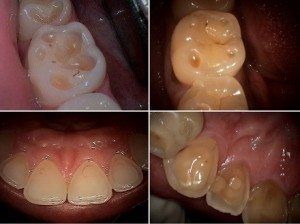Acid Attack! Acid Erosion and Teeth

Could you be causing irreversible harm to your teeth every day?
Many of the foods and drinks we consume daily are acidic. In addition, health conditions such as GERD (acid reflux) and eating disorders subject one’s teeth to damaging acids. Did you ever do that “science experiment” as a child when you put a dirty penny in Coca Cola and in a short time it was magically clean? Now imagine a tooth dissolving instead of that penny. Yeah, scary.
Signs and Symptoms of Acid Erosion:
- Sensitivity. The protection against insult provided by the outermost layer of your teeth (the enamel) has become compromised.
- Discoloration. When enamel is lost, the underlying dentin layer is more visible. Dentin is darker in color (and more yellow!) than enamel.
- “Rounded” teeth. Caused by acid wear patterns.
- Transparency. This becomes apparent on the edges of front teeth.
- Cracks and roughness. Your teeth are no longer as strong as they once were!
- “Cupping out” of the chewing surfaces of back teeth.
Keep in mind…Anything with a pH below 5.0-5.7 triggers dental erosion, causing the hard outer enamel of your teeth to, basically, dissolve!! While a lot of the foods and drinks that fall into this category are common knowledge, others may come as a surprise to most!
Acidic Foods and Drinks Include:
- Drinks: Fruit juices, Lemonade, Sports drinks, some brands of bottled water, Coffee, Carbonated beverages:, Alcohol
- Most fruits & Some Veggies: Including Rhubarb, Spinach, Mashed potatoes
- Condiments: Jellies and Jams, Honey, Molasses, Maple Syrup, Soy Sauce, Worcestershire Sauce, Chili Sauce, Ketchup
- American Cheese, Cottage Cheese, Yogurt
- Jell-O, Pickles
- Roasted Nuts: Pecans, Walnuts, Cashews
Some Simple Steps You Can Take to Help Protect Your Teeth
1. Don’t let acidic foods or drinks linger in your mouth
2. Drink acidic drinks through a straw and NEVER swish your drink between your teeth!
3. After consuming something acidic, rinse with water to help neutralize the pH of your mouth.
4. After eating/drinking something acidic, wait at least an hour before brushing. Enamel remains soft for awhile after acid exposure, and brushing too soon can perpetuate the problem!
5. The frequency of acid exposure is more significant than the amount of acidic foods/drinks consumed. If you have to drink a soda, don’t sip it over a prolonged period of time.
6. Ask your dentist or dental hygienist about various products and services that can be used to treat acid erosion. To help with sensitivity, prescription strength toothpaste or Fluoride treatments can help. If a significant amount of tooth structure has been lost due to acid erosion, your teeth may need definitive restorative treatment.
